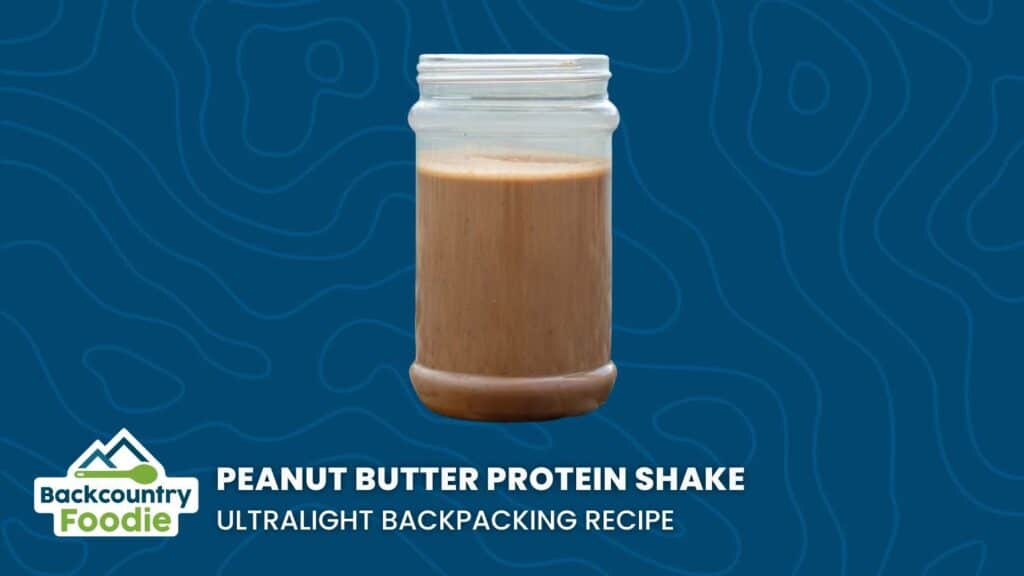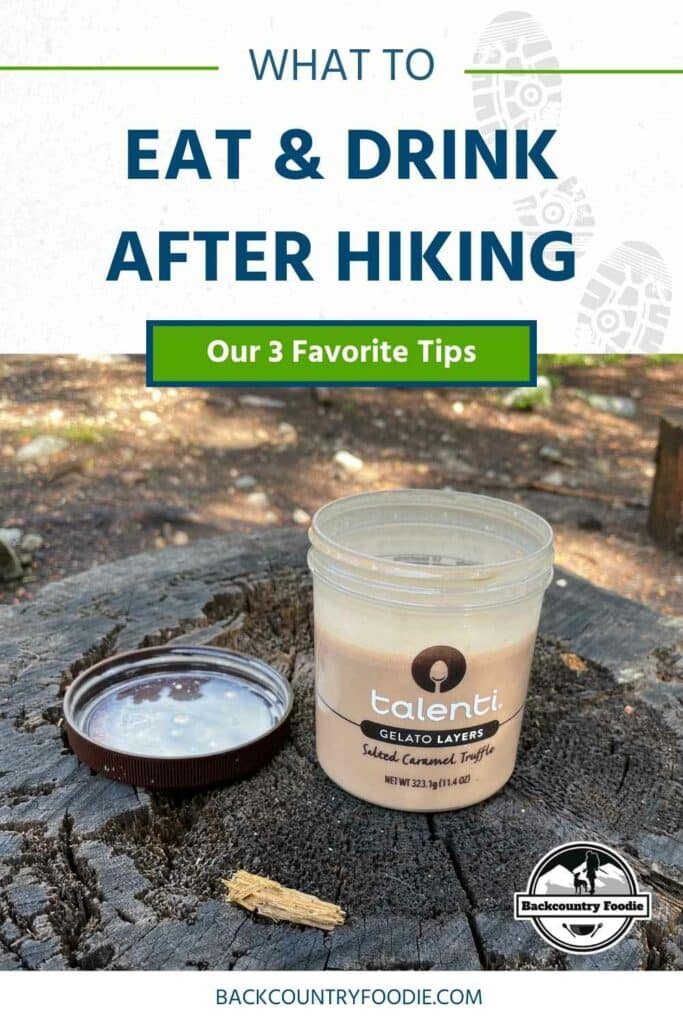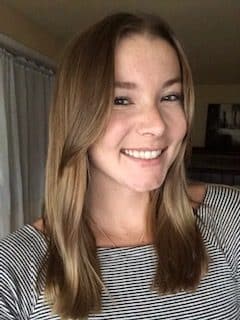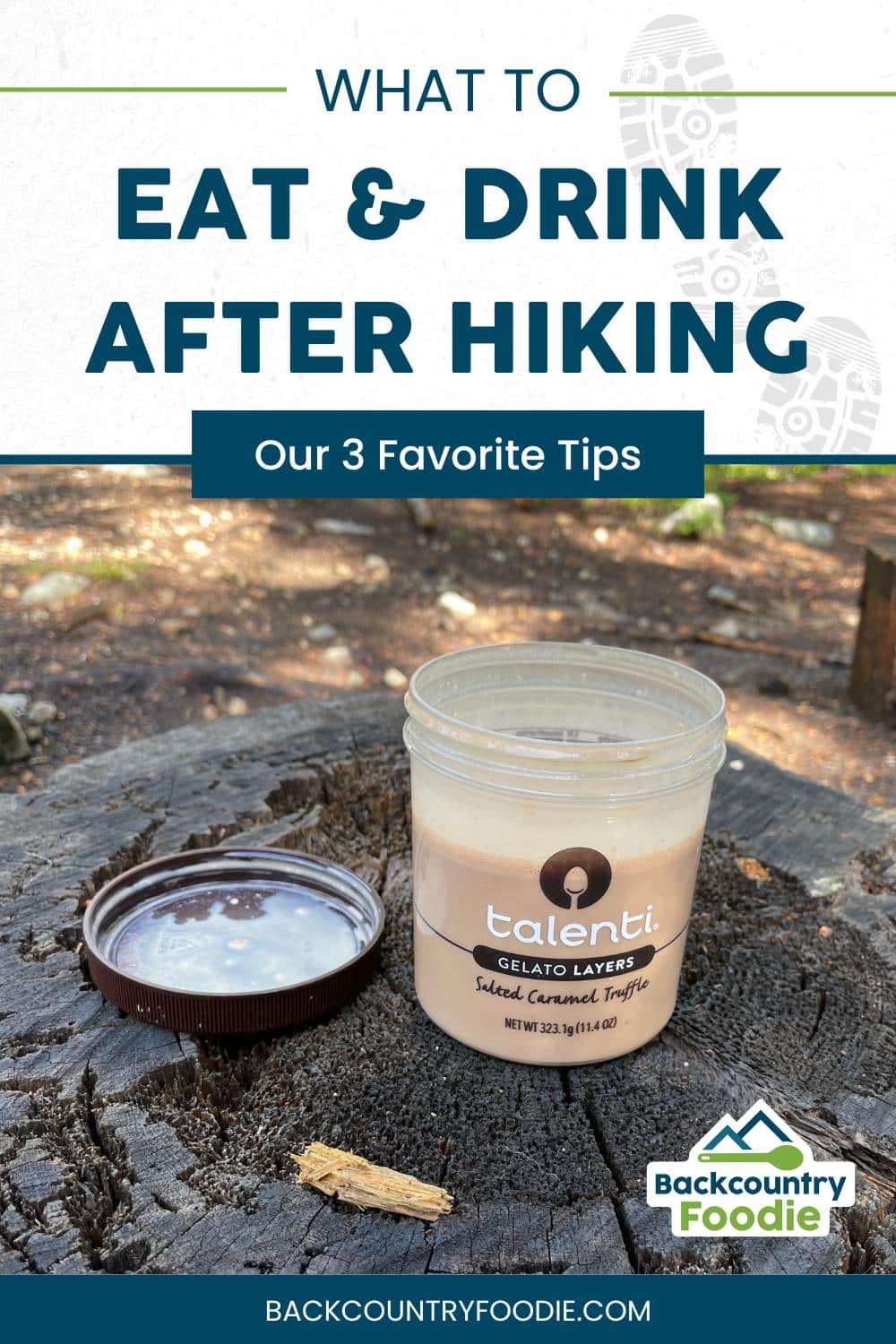What to Eat and Drink After Hiking – Our 3 Favorite Tips
By Jordan Marthens, MS & Aaron Owens Mayhew, MS, RDN, CD
Updated January 14, 2024
This post may contain affiliate links.

One of the most frequent questions we’re asked is what to eat and drink after hiking for post-hike recovery. Why is this such a great question? Eating and hydrating to support muscle recovery after hiking is just as important as fueling during your hike. It can be easy to overlook because we’re typically tired after a long day of hiking and want to relax as soon as possible. However, taking the time to eat well for post-hike recovery can impact how you feel the following day. Focusing on replenishing fuel stores, reducing soreness, preventing muscle breakdown, and maintaining hydration status can make all the difference.

What to Eat and Drink After Hiking – Tip #1
Fluid and Electrolytes
Hydration goes hand in hand with the food we eat for fuel. Without it, we feel fatigued and experience negative physiological symptoms (e.g., dizziness, rapid heartbeat, fatigue, and headaches). Fluids and electrolytes work together to help hikers quickly recover physically and mentally. Electrolytes are minerals — such as sodium, potassium, calcium, and magnesium — that allow our bodies to work properly. These minerals are important in maintaining our fluid balance, muscle contractions, and energy production. We lose electrolytes, mainly sodium, in sweat; therefore, it is important to rehydrate with sodium. Factors that affect hydration include extreme heat/cold, high sweat loss, and altitude. Plan ahead to track your water intake throughout the day and drink additional fluids after your hike.
For every 1 lb (~0.5 kg) weight lost during your hike, drink an additional 24 oz (720 mL) of fluid. For example, if you lose 3 lbs after a day of backpacking, add 72 oz (~2L) of fluid. Calculation: 3 lbs x 24 oz = 72 oz
Water is not the only way to rehydrate.
In fact, food and other drinks provide more electrolytes than water and even sports drinks.
To meet your fluid and electrolyte needs, try these food ideas:
- Powdered chocolate milk drink – Carnation Breakfast Essentials®
- Whole milk powder – Nestle® Nido
- Crackers with peanut butter
- Pasta with meat sauce
- Plantain chips
- Salted nuts & seeds mixed with dried citrus fruit
- DIY powdered citrus fruit & banana smoothies
Over-hydration (Hyponatremia)
There is such a thing as too much hydration. Our bodies can only absorb so much fluid at a time. When we consume too much, this will throw off our fluid balance and dilute electrolytes. Bad headaches, puffy fingers and ankles, and a bloated stomach are some easy signs of overhydration. Lethargy and confusion are also signals of a disturbed fluid balance. It is important to know the signs of overhydration as they may lead to seizures, comas, and death.
Tips for staying hydrated:
- Know where to find water
- Have drink mixes available
- Pre-hydrate to produce light-colored urine
- Increase fluid intake when intense sweating anticipated
- Drink early and often, but don’t overdrink
- Pack adequate fluid in your backpack
- Train yourself to drink more while hiking than at home
- Check your body weight after hiking
- Complete rehydration requires fluid AND sodium
- Drink by schedule, not thirst
- Know the warning signs of dehydration
Consider checking out our video about hydration while backpacking.
What to Eat and Drink After Hiking: Tip #2
Carbohydrates and Protein After Hiking
Hiking depletes your carbohydrate stores (muscle glycogen) and causes muscle breakdown. Carbohydrates provide our main energy source; therefore, we need to replenish what was lost while hiking. Protein will stimulate muscle protein synthesis and prevent muscle protein breakdown caused by hiking. When paired together, there is a greater insulin response. Insulin is a hormone that transports carbohydrates into the muscle for storage and helps build muscle. In addition, carbohydrates reduce cortisol, a hormone that breaks down muscle.
In other words, carbohydrates and protein make a great team and will speed up recovery.
* To offset the negative impact of hiking, consume a 3:1 ratio of carbohydrates to protein. * For example, consuming 60 grams of carbohydrates and 20 grams of protein would equal the ideal ratio for recovery post-hike. * To maximize muscle repair, aim for 15-25 grams of protein for recovery after backpacking.
Examples of a 3:1 ratio:
- Powdered chocolate milk drink (Carnation Breakfast Essentials)
- Trail mix: 1/2 cup (70 g) of nuts + 1/3 cup (45 g) of dried fruit
- 2 cups (56 g) of Freeze-dried yogurt + 1/3 cup (45 g) of nuts
- 2 cups (300 g) of quinoa/rice/pasta + 2 oz (56 g) dehydrated meat + sauce
- Fig bar + 1 oz (28 g) of beef jerky
Examples of 15-25 grams of protein:
- 2 oz (56 g) of dehydrated meat
- 1/2 cup (70 g) of nuts
- 1-2 scoops of protein powder
- Protein bar
- 1 cup (190 g) of beans or lentils
Chocolate Milk – the perfect post-hike recovery drink!
A powdered chocolate milk drink can provide all of the key factors of recovery; fluid, electrolytes, and a 3:1 ratio of carbohydrates to protein. In addition, it is tasty and affordable. Consuming powdered chocolate milk immediately after hiking may reduce muscle damage and prepare you for another day of backpacking.
Give our carbohydrate and protein-rich Peanut Butter Protein Shake meal replacement recipe a try!

What to Eat and Drink After Hiking: Tip #3
Antioxidants and Post-Hike Recovery
The physical demands of hiking and backpacking create stress on our bodies. Focusing on antioxidant (Vitamins C & E) rich foods may diminish these effects. It is recommended to consume an antioxidant-rich diet rather than supplements to protect against damage.
Sources of Antioxidants in Hiking Food Dried fruits: cherries, strawberries, blueberries, and mangoes Nuts & Seeds: sunflower seeds, peanuts, and almonds
Learn more about antioxidants and post-hiking recovery food via our “Exercise-Induced Inflammation: Is your hiker diet helping or hurting?” post.
Key Post-Hike Recovery Tips to Remember:
Goals |
Strategies |
| Replace fluid and electrolyte losses | Drink 24 oz (720 mL) of fluid for every pound lost during exercise, or maintain a goal of 90-150 oz (3-5 L) per day |
| Restore muscle/liver glycogen stores | Focus on a 3:1 ratio of carbohydrates to protein within 2 hours after exercise and again 2 hours later |
| Promote muscle repair | 15-25 g of high-quality protein should be consumed immediately after a hike |
| Add antioxidants to your diet | Focus on Vitamin C & E foods |
READY TO LEARN MORE ABOUT WHAT TO EAT AFTER HIKING?
Backcountry Foodie is your go-to resource for over 200 ultralight backpacking recipes, an automated meal planning tool, virtual masterclasses, YouTube videos, and podcast interviews.

Did you enjoy this post?
Pin it and share it with your fellow hikers.

Interested in learning more about post-hike recovery on the trail?
Check out these posts:
- Exercise-Induced Inflammation: Is your hiking diet helping or hurting?
- What to Eat and Drink While Hiking in Hot Weather
- Top 6 Nutrition and Hydration Tips for High Altitude
- A Look at Supplements, Meals, and Snacks for Muscle Recovery
- Backpacking Water Purification: Beyond Filters
- 100 of Our Favorite Grocery Store Backpacking Foods
ABOUT THE AUTHORS:
Jordan Marthens, MS, is completing her Dietetic Internship at Seattle Pacific University to pursue a career as a Registered Dietitian. As a former collegiate athlete, she takes a special interest in sports, active lifestyles, and overall wellness. She loves everything food-related and does not go a day without coffee or dessert.
Aaron Owens Mayhew, MS, RDN, CD, is a registered dietitian and ultralight long-distance backpacker with over 20 years of nutrition and backpacking experience. She’s also the founder and owner of Backcountry Foodie, an online ultralight recipes and meal planning platform for backpackers. She also enjoys teaching hikers about backpacking nutrition via virtual masterclasses, YouTube videos, and podcast episodes. You can follow Aaron’s adventures in the kitchen and the backcountry via Instagram and Facebook.
Sources:
- Clark, N. (2019). Nancy Clark’s sports nutrition guidebook. Human Kinetics.
- Ivy J. L. (2004). Regulation of muscle glycogen repletion, muscle protein synthesis, and repair following exercise. Journal of sports science & medicine, 3(3), 131–138.
- Karpinski, C., & Rosenbloom, C. A. (2017). Sports nutrition: a handbook for professionals. Academy of Nutrition and Dietetics.




2 Comments
Great article. But the link to the glycogen article. maybe if you could translate that to us Lay people. So we could figure out how much to use while hiking. such as say, Gu for glycogen replenishment.
Our bodies typically run out of glycogen (stored carbohydrate) within 1-3 hours based on the level of intensity of the hike. If hiking <3 hours, 30-60 grams of carbs (listed on the food label) should suffice. If hiking >3 hours, consume 30-60 grams of carbohydrates every 60-90 minutes based on the hike’s intensity. There’s no need to eat more than 60 g of carbs at once because the average hiker can only use that much at once. Some studies have shown that elite athletes can utilize/store more carbs. Based on the food label, Gu gels have 22 g carbs. Keep in mind that you don’t have to invest in sports gels. Regular food works better for recovery because it will likely also contain protein, whereas gels do not. I hope that helps. Thanks for reading and reaching out.